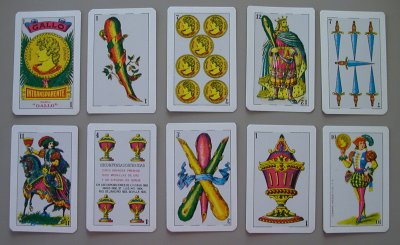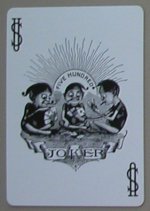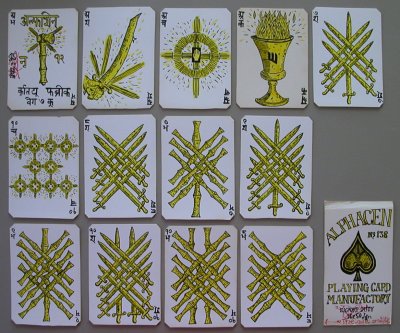Mad About Playing Cards, Part 2
Continued from Part 1 yesterday...

Fig. 6 Mexican playing cards, 40-card deck with Spanish suit signs of swords, clubs, cups, and coins. "Intransparente, Marco 'Gallo.'" This is one of many Mexican card decks I bought on vacation in Tijuana in the spring of 1986. I found some off-the-beaten-path shops, explained in my stumbling Spanish that I was looking for Mexican playing cards. They tried to foist off onto the gringo some Mexican-made playing cards with spades, clubs, hearts, diamonds; but no, I wanted the local product, funky, the real thing.
I think this deck may be my favorite of all the ones I brought back from Mexico: the design and the colors are very fine and subtle. The texture of the pasteboard is also nice, though I'm not sure how long it would hold up under use.

Fig. 7 Here's a piece of real Americana: Rook cards, 57-card deck with four suits— yellow, red, green, black— numbered from 1 through 14, plus of course the eponymous Rook card. (Yes, I said "eponymous": go look it up.) I have several decks of Rook cards in my collection, some of them very recent. But this is my oldest deck: the rule book lists no copyright renewal date later than 1943.

Fig. 8 This is one of the very first card decks I added to my playing card collection, back when I was 12 or 13. It's a 63-card deck for six-handed Five Hundred. Ten cards to each player, three cards to the blind. Your eyes are not playing tricks on you, the deck includes ♠12, ♦11, and ♥13. In fact all four suits contain an 11 and a 12, and the red suits also contain a 13. Count it up, with the joker that makes 63 cards.

Fig. 9 By the way, that joker, with the three gnomes playing cards and smoking in the mist of the dawn, was a more important part of my whole early "aweful platonic mystery at the heart of all games" mythos than you might imagine. To my young mind, that joker depicted the awesome land where cardplayers play cards in the stillness of the early dawn (Hermetic: mna sralo), with the sun perpetually rising in the west behind them, and the drone of vacuum cleaner motors in the background. No, that's far enough: I could go into much more detail, but it would only get more incomprehensible the further I went. Like, completely insane incomprehensible.

Fig. 10 Ah! Finally we come to some playing cards which I myself designed and drew some time in my college years.
Thirteen of the cards are from an unfinished deck, with suits of swords, staves, urns, and thunderquoits. In my own Hermetic language, that's mna zivi, mna cthini, mna chthiji, and mna prontthori. Or, for some reason, these cards are labeled in some rendition of Devanagari writing (you know, as in Sanskrit), with suit names of śaştri, bhastonai, kopē, and chakrē. The card in the upper left, the ace of staves (aş bhastonai kū, Hermetic mna vorthad cthinil) bears the heavy-duty inscriptions, sort of like our ace of spades. In addition to all the quasi-Hindic, I notice handwritten in red ink on the left side of this ace in Hermetic daratha, "paid," indicating that the mercantilist export tax on this card deck has been paid by the manufacturer.
Ditto on the ace of spades at lower right, "Alphacen Playing Card Manufactory, No. 138, Export Duty
You see what happens when you turn me loose with an entire New Year's Day in which to work up blog posts... I go spinning off into "radioactive core meltdown" utter playing card insanity!
Labels: games








2 Comments:
oh! The Horror! "Yellow" rook cards. Because we ALL know they're really orange. As was explained to me in great detail last week when my parents visited and we taught the kids to play Rook, admist much confusion. "Didn't they know their colors? I know MY colors and that isn't yellow."
Yeah, I've noticed that about "yellow" Rook cards. I've sometimes thought it's a concession to legibility. At other times I've thought of it in terms of the curious irregularities I've so often encountered in the play and artistic design of classical card games and board games: it seems there are few really classic games without any irregularities. What would euchre be without the right and left bowers? What would chess be without castling?
By mental connect-a-dot the "yellow"/orange Rook cards also remind me of the pieces in the game of Barsoomian Chess, or Jetan, from Edgar Rice Burroughs' novel The Chessmen of Mars. Burroughs' game (which is surprisingly playable) pits black pieces against orange pieces; and oddly enough, Burroughs comments that on Mars the game "is presumed to have originally represented a battle between the Black race of the south and the Yellow race of the north." So there's yet another game with orange in place of yellow.
Post a Comment
<< Home